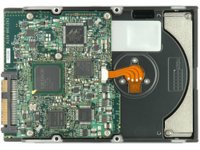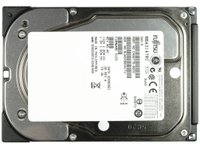How Do SSDs Redefine Storage Performance?
It only takes one or two modern SSDs to outperform business-class RAID arrays with four or eight hard drives. We're running a full comparison and looking at the implications for high-performance systems when you make the transition to flash-based tech.
The HDDs: Fujitsu MBA3147RC (147 GB, 15 000 RPM)
The MBA3147RC by Toshiba (formerly Fujitsu) is one of the last 3.5” 15 000 RPM hard drives with a 3 Gb/s SAS interface. Newer drives are available from Hitachi and Seagate, but we happened to still have eight of these enterprise drives in our test lab. Since I/O performance hasn’t increased much recently, we decided these drives still represent what will be running in many business environments today.
We used eight 147 GB models, but there are 74 GB and 300 GB versions of this drive, too. All have a 16 MB buffer, 1.4 million-hour MTBF, and five-year warranty.
A 122 MB/s maximum transfer rate isn’t that special anymore; hard drives reached 200 MB/s a while back. However, I/O performance is still close to what you’d get from more current 15 000 RPM drives, plus ganging four or eight drives into a RAID naturally boosts overall performance. Utilizing even faster hard drives wouldn’t make much difference given the already-significant performance gap between HDD and SSD.
Please look at our Enterprise HDD Charts for comparison data on these hard drives.


Get Tom's Hardware's best news and in-depth reviews, straight to your inbox.
Current page: The HDDs: Fujitsu MBA3147RC (147 GB, 15 000 RPM)
Prev Page The SSD: Samsung 470-Series (MZ-SPA256, 256 GB) Next Page Can RAID Beat The SSD?